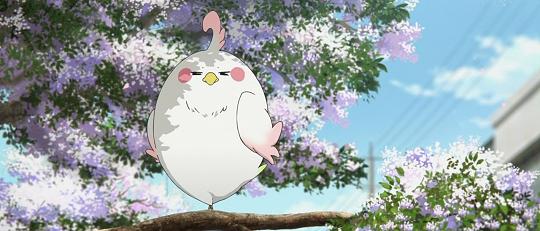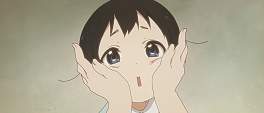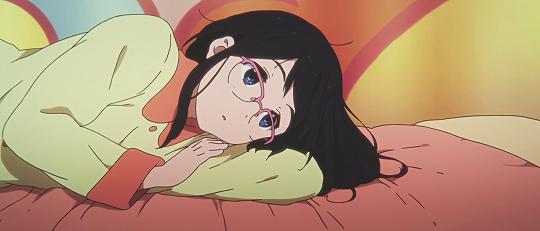Tamako Market was always a bit of a mongrel when put up against other Kyoto Animation productions. Coming after the first season of otaku targeted Chuunibyou and before the first season of the, one presumes predominantly female targeted, Free!, Tamako Market certainly didn’t set the world on fire like K-On! did, Naoko Yamada’s previous directorial role, and it seemed to sink without a trace after airing early 2013. So the series sat forlornly in my “Watched” folder, awaiting some kind of spark that would elicit more than a disinterested shrug whenever I considered writing about it.
That spark came with the movie, Tamako Love Story, set after the series and deals with… well… Wait, rewind. Tamako Market is about a girl called Tamako: daughter of a family of mochi makers and the much loved teen of a Kyoto municipal shopping arcade. A talking bird named Dera arrives from an unspecified distant land, apparently searching for a bride for his country’s prince, and proceeds to ingratiate himself with Tamako’s family. However, he becomes fat and complacent from eating so much of the mochi they make, until it becomes increasingly imperative he complete his original mission.
If you were to judge from that description and the jaunty opening alone, you would probably correctly guess that Tamako Market is an upbeat light-comedy with a talking tropical bird set in a quirky, communal shopping mall. At least, that’s what the series is about until the movie takes a decidedly different direction. With no Dera in sight apart from a brief, humorous pre-roll vignette, the movie lives up to its title by being a love story; and not the happy-go-lucky kind that you would guess coming off the back of the series. Overall it’s certainly a positive story, but the second act is a quagmire of angst, drama and introspection that is quite apart from what the series busied itself with.
The series is stoically cheery, with the antics of the cheeky Dera and his unyielding sense of pride driving a lot of the affable comedy. There is a certain amount of drama occurring in the background, however the series is largely viewed through Dera, so his japery and the mystery behind his mission (and why he can be used as a makeshift projector) forms the spine of the narrative, with secondary stories like Anko’s first love or newcomer Choi’s adjustment Japan taking precedence over, for instance, Mochizou mooning over Tamako. The threads given prominence in the movie are still present in the series but comparatively and dramatically underplayed.
So in the series, Mochizou (the other half of the titular “love story” in Tamako Love Story) is shown to have feelings for Tamako and his half-assed attempt at confessing to her (through Dera, natch) is thwarted by the somewhat abrupt Midori (who herself has feelings for Tamako in a wonderfully subtle bit of storytelling and characterisation). Though we only see him with a video camera once before it, Mochizou is in fact a paid-up member of the movie making club as the movie goes through great pains to demonstrate; likewise his cohorts are glimpsed fleetingly, yet get entire dialogues and hand-slang in the movie.
It’s an odd, but not unwelcome, turnabout. Tamako Market thrived on fostering a strong sense of community within its cast, whether that was with the shopping district and its rogue’s gallery of shopowners, or the great sense of a familiarity within Tamako’s close family with drawings on the wall from when her and her sister were younger and a beguiling sense of tacit understanding between them all. However, by focusing on the broader aspects of Tamako’s life, it means that her baton club hijinks are pushed to the sidelines, with fifty percent of the club members totally unknown and the school-club plot stalwart of a big performance coming without warning in episode nine rather than episode twelve. Tamako’s friendship circle is wide, with members from her club, her school and her community, making the usual “club members are my only friends” mentality of similar series seem downright blinkered.
In short, the plot of the series was muddled, but felt purposely so. As if the barely constrained bedlam of the busy shopping district bled through to the narrative: one episode revolves around rumours of ghosts and a haunted house, another has Tamako befriend proto-Mio Shiori (who thankfully is subsequently used sparingly). The whole idea about a rotund talking, and eventually fortune telling, bird is a pleasingly odd and epitomises the off-beat sense of humour that left the series feeling wayward and somewhat shallow.
The movie then is anything but. Shedding Dera as the “narrator” changes the atmosphere drastically to be, not so much deadpan serious, but more focused on character drama than idiosyncratic comedy. Coming from Kyoto Animation it is also unspeakably gorgeous and a rampage of brilliant direction, proving not only that the studio can still wow even so long after Full Metal Panic: TSR, but that Naoko Yamada is a fantastically skilled director.
I may be biased having heard her speak and seen her enthusiasm first hand, but shot after shot and scene after scene in Tamako Love Story proves her talent and serves to underscore a lot of the themes that sprout from the series’ foundations. Tamako is still the protagonist and is still as adorably cheery as before, even when clinging to sleep and wandering with tousled hair; yet now in her final year of high school, heavy decisions about her future need to be made. Mochizou too chooses, with that wonderfully arbitrary teenage logic, that he must tell Tamako how he feels before he leaves for the big(ger) city.
Bifurcated between their two viewpoints, the film begins with Mochizou and his bashful trepidation at confessing his feelings to his childhood friend, followed by Tamako as she processes what those feelings mean while simultaneously accepting her right to choose her future rather than be swept along by it. The opening half goes to great lengths to portray Tamako as a burgeoning woman rather than a flighty child, with notice paid to classically feminine features (breasts and bums), as well as positioning her separate to Mochizou with many scenes dividing the two with male and female toilets, male and female public bath entrances, even the analogy of the river’s two shores and the stepping stones in between (points awarded for remembering Kaji’s speech to Shinji about the kanji for woman in Evangelion).
The latter half then lays the symbolism on thick, with Tamako’s inability to catch the cup-and-string “phone” her and Mochizou use as well as her club’s baton a metaphor for her accepting Mochizou’s feelings as well as thinking about her future; no longer is she just going to be the daughter of a mochi maker but can choose, if she wants if she can grab a hold of it, what to do.
All of this is photographed through a kind of old-style camera filter, washing out the colours and blurring the edges of the screen. The series may have taken up a full year of in-story time - from winter to winter - but this is an endless summer with deep ocean skies and flesh pink sunsets gifting the whole film with a slightly dream like quality. And of course there is KyoAni’s enviable animation on display in high definition and glorious gradation with everything from furtively idle feet to the slick shine floor of a school gym rendered beautifully and inimitably.
That thematic division between the series and movie though still niggles, especially after such a wonderful, heartwarming send-off. Even in the soundtrack you can hear the difference in tone, with lonesome piano melodies for the film and brass-band bolshiness for the series. Little xylophone ditties as Dera embarks on his latest escapade versus violin strains of a confession at dusk. The movie takes that ephemeral sadness of life irrevocably changing, that the director captured so perfectly in the ending of K-On!!, and stretches it out to eighty minutes with elegies for missing parents and events left unspoken. The series on the other hand was about a corpulent bird who couldn’t even fit inside a birdbox that was crafted just for him. Despite sharing characters then, the two productions feel like almost totally separate genres.
Such a juxtaposition between the two would likely raise more ire if Tamako Market had a stronger sense of character to it. That may seem unduly mean, but beyond the infectious happiness of its lead and a bird bereft of willpower, there wasn’t much else going for it. Tamako Love Story on the other hand takes the strongest elements of the series: community, youth and love, and produces something befitting both its studio and its director.
Even with the difference between them though, the movie does not stand alone. The broader story of Tamako and Mochizou’s romance would remain, but elements like Midori’s standoffishness towards Mochizou, or Kanna’s deadpan love of angles, or the quiddities of the other shopping mall denizens would be lost. Not to a huge detriment perhaps but all contribute to the unique texture that remains constant in both the series and the movie.
Be under no illusion that it is a chore to watch the series, just like Birdy’s first season, it is not a case of “powering through” to get to the phenomenal second instalment. The series is enjoyable and easy watching, but finishing with such a strong movie fills me with hope for a studio that I perhaps haven’t always shared a broader enthusiasm for, but until recently always respected what they produced. Tamako Market may have been idle enjoyment, but Tamako Love Story is one of the first KyoAni productions for a long time that I have unreservedly enjoyed and a superb finale for a cast of characters that deserved more than the original series delivered.





















